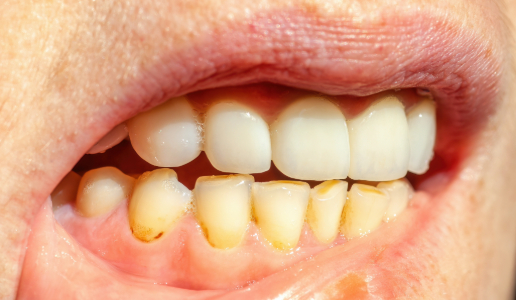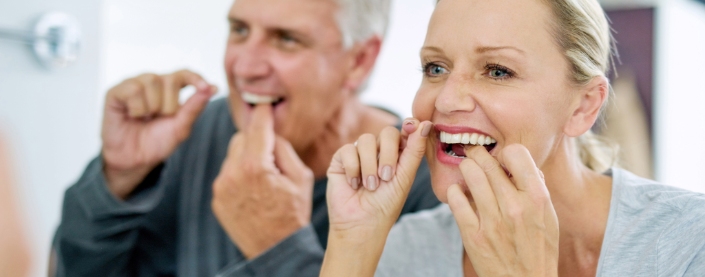What Causes Plaque on Teeth
Bacteria in your mouth are mostly responsible for causing plaque. These bacteria release acids that break down sugary and starchy foods or beverages you consume, and the combination of bacteria, acids, food debris, and saliva can mix into that colorless film on your teeth.
Plaque vs. Tartar: What’s the Difference?
Although plaque and tartar are related, they are not the same. Tartar, or dental calculus, is plaque buildup that hardens over time, typically due to poor oral hygiene. Similarly, while plaque is generally colorless, tartar may have more of a yellowish tint or appear darker because of things like coffee, tea, wine, smoking, or tobacco.
Perhaps the biggest difference in terms of dental plaque vs. tartar is how you go about removing them. For example, brushing twice a day and flossing regularly can help to remove plaque on teeth. Conversely, you cannot remove tartar on your own at home—only dental professionals can remove hardened plaque.
How to Remove Plaque on Teeth
No need to feel petrified by the thought of plaque or removing it from your teeth! Sticking to your oral hygiene routine and practicing good habits can help you get rid of plaque on teeth:
Floss Daily… Before You Brush!
If your string of floss has gotten buried somewhere in your bathroom cupboard or other personal items, it’s time to get it out! Flossing helps to loosen plaque—particularly in areas that may be harder to reach when you’re brushing—that is then more easily removed when you brush.
And yes, the order in which you floss and brush matters. A past study indicated that participants who flossed before brushing experienced far greater plaque reduction between the teeth and along the gumline compared to people who brushed first, and then flossed.
Flossing has fantastic oral care benefits. So make sure you and your kids set aside some time to floss at least once every day before brushing your teeth, either in the morning or at night before bedtime.
Brushing Bookends: Clean Your Teeth at Morning and at Night
Have you ever wondered if there’s an optimal time for you to brush your teeth? Maybe you’re teaching your kids how to brush and trying to establish a consistent routine. The best way to think about your brushing routine is to clean your pearly whites when you first wake up and just before you go to bed.
Brushing your teeth in the morning when you first wake up helps to address some of the natural bacteria that occur overnight when you sleep. It boosts your saliva production, and the fluoride in the toothpaste coats your tooth enamel with something of a shield to help guard against the acids in the foods you eat.
It’s a good idea to wait about an hour to brush your teeth after dinner. And if you forgot to brush when you first woke up and already had your breakfast, you should also wait around an hour before cleaning those chompers. Either way, you should try to brush twice each day!
Use an Electric Toothbrush!
Manual toothbrushes have their benefits in that they are inexpensive and portable. But as far as the ideal plaque remover for your teeth: that would be an electric toothbrush.
Electric toothbrushes remove up to 70 percent more plaque than manual toothbrushes in hard-to-reach places, offering over 1,000 strokes per minute compared to 300 or fewer for manual toothbrush users. And the benefits extend beyond plaque removal! Previous studies have shown that electric toothbrush users experienced 22 percent less gum recession and an 18 percent reduction in tooth decay and cavities vs. manual toothbrush users.
Need more reasons to buy an electric toothbrush? Well, they’re very easy to use. You only need to use your hand as a guide and let your brush do the spinning to help with an effective clean. Plus, many electric toothbrushes come with replaceable brush heads that you can swap out if the bristles become frayed or worn.
Feeling convinced to try an electric toothbrush? If so, add Spinbrush™ electric toothbrushes to your rotation! Spinbrush™ offers several electric toothbrushes for both kids and adults, including:
- Spinbrush™ PRO Clean removes 70 percent more plaque vs. a manual brush in hard-to-reach places and has a hydro-blocking SoftSwitch to help prevent water from leaking inside your toothbrush.
- Spinbrush™ PRO+ Gum Health also features extra-long bristles and removes 2X more plaque along the gumline in clinical studies vs. a manual toothbrush.
- Spinbrush™ Super Mario™ Kid’s Toothbrush helps your kiddos fight cavities by removing 2X more plaque than a manual toothbrush. Kids also brush 38 percent longer with a Spinbrush™ toothbrush vs. a manual toothbrush.
Our other kid’s toothbrushes offer more character connections that can reflect the different ages and stages your little ones go through, including CoComelon™, Spider-Man™, and more! So, what are you waiting for? Grab the Spinbrush™ electric toothbrushes of choice for you and the family so you can get rid of plaque with a toothbrush that can help you and the kids enjoy doing it!
Try a Baking Soda Toothpaste
Baking soda toothpastes are especially effective at removing plaque on teeth. According to past research, people who brushed their teeth with toothpaste containing baking soda removed more plaque and experienced reduced plaque growth over 24 hours compared to people who brushed their teeth using toothpaste that did not contain baking soda.
As an alkaline substance, baking soda helps to neutralize acids in your mouth when you eat or drink. That makes it more difficult for plaque to grow on and in between your teeth. Plus, as a mild abrasive, baking soda gently and effectively helps to whiten your teeth.
ARM & HAMMER™ Toothpastes are made with 100 percent baking soda and come in a variety of formulas that can help to clean and whiten your teeth and gums, remove plaque, and relieve bad breath. Find the ARM & HAMMER™ formula that works best for you!
Go See Your Dentist!
It’s essential that you see your dentist at least once a year. They can take X-rays and scans to help spot any potential issues with your teeth and gums while also cleaning your teeth to help remove plaque.
How to Help Prevent Plaque Buildup
Now that you know how to remove plaque on teeth, what about preventing plaque buildup over time? Flossing daily and brushing twice each day is a necessity. Additionally, you might consider:
- Mouthwash: Use an antiseptic fluoride mouthwash to help remineralize your teeth and fight some of the bacteria that cause plaque.
- Sugar-free chewing gum: According to the American Dental Association (ADA), chewing gum can help increase saliva production, which can play a role in washing away leftover food debris.
- Keep tabs on your diet: You can’t always stay away from tasty sweets and drinks. However, mixing in more healthy snacks like yogurts, cheese, vegetables, and fruit may help reduce plaque buildup by not allowing the bacteria in your mouth the chance to interact with an abundance of sugars and carbohydrates.
It’s important to remember that outright preventing plaque is essentially impossible because you’re susceptible to plaque growth every time you eat and drink. But adding some of these things to your oral care routine, including brushing and flossing, can help limit your chances of plaque contributing to tooth decay and gum disease or cavities.
Put Plaque in a “Spin” Cycle!
Got plaque on your teeth? You’re not alone! Having plaque on your teeth is a perfectly normal part of the human experience. What’s important is that you take steps to reduce plaque buildup, brush, and floss consistently, and see your dentist to get rid of plaque consistently and effectively. And when you brush, consider doing so with a Spinbrush™ electric toothbrush to help put plaque in its place!





